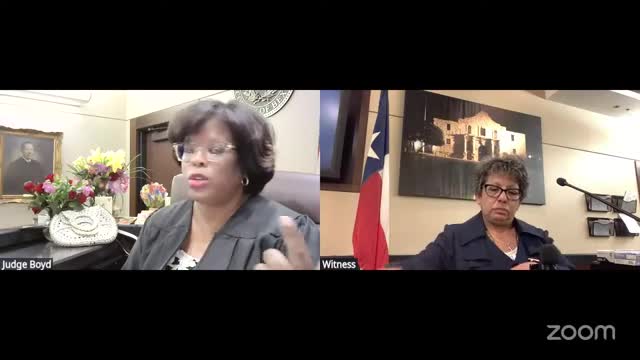Court examines fingerprint evidence in Jalen Bell case during cross examination
April 09, 2025 | Judge Stephanie Boyd 187th District, District Court Judges, Judicial, Texas
This article was created by AI summarizing key points discussed. AI makes mistakes, so for full details and context, please refer to the video of the full meeting. Please report any errors so we can fix them. Report an error »

In a tense courtroom atmosphere on April 9, 2025, Judge Stephanie Boyd presided over a pivotal hearing in the case of State vs. McIntyre at the 187th District Court in Texas. The focus of the proceedings centered on the admissibility of fingerprint evidence, a crucial element in the prosecution's case.
As the cross-examination unfolded, attorneys engaged in a rigorous debate regarding the qualifications of a fingerprint expert. One attorney challenged the expert's credibility, questioning whether her methods adhered to established scientific principles. The courtroom buzzed with anticipation as the judge sought clarity on the nature of the challenges being posed. "Are you challenging her expertise?" Judge Boyd inquired, emphasizing the need for precise questioning under the relevant legal standards.
The discussion highlighted the complexities of forensic science in the courtroom. The attorney representing the defense argued for a deeper inquiry into the scientific validity of fingerprint analysis, referencing the Daubert and Kelly standards that govern expert testimony. This legal framework requires that the methods used in forensic analysis be scientifically sound and properly applied.
The expert witness, who had analyzed a fingerprint lifted from a blue iPhone, confirmed that she had compared it to known prints from a suspect, Jalen Bell. Her conclusion was that the prints matched, a determination that could significantly impact the case's outcome. However, the defense's insistence on scrutinizing the underlying scientific principles underscored the ongoing debate about the reliability of fingerprint evidence in criminal proceedings.
As the session progressed, the judge allowed the questioning to continue, aiming to streamline the process while ensuring that all necessary facts were disclosed. The courtroom atmosphere remained charged, with both sides aware that the implications of this testimony could resonate far beyond the immediate case.
With the jurors soon to be brought back in, the stakes were high. The outcome of this hearing could set a precedent for how fingerprint evidence is treated in future trials, reflecting broader concerns about the intersection of science and law in the pursuit of justice. As the proceedings resumed, all eyes were on the witness, whose testimony could either bolster the prosecution's case or raise significant doubts about its validity.
As the cross-examination unfolded, attorneys engaged in a rigorous debate regarding the qualifications of a fingerprint expert. One attorney challenged the expert's credibility, questioning whether her methods adhered to established scientific principles. The courtroom buzzed with anticipation as the judge sought clarity on the nature of the challenges being posed. "Are you challenging her expertise?" Judge Boyd inquired, emphasizing the need for precise questioning under the relevant legal standards.
The discussion highlighted the complexities of forensic science in the courtroom. The attorney representing the defense argued for a deeper inquiry into the scientific validity of fingerprint analysis, referencing the Daubert and Kelly standards that govern expert testimony. This legal framework requires that the methods used in forensic analysis be scientifically sound and properly applied.
The expert witness, who had analyzed a fingerprint lifted from a blue iPhone, confirmed that she had compared it to known prints from a suspect, Jalen Bell. Her conclusion was that the prints matched, a determination that could significantly impact the case's outcome. However, the defense's insistence on scrutinizing the underlying scientific principles underscored the ongoing debate about the reliability of fingerprint evidence in criminal proceedings.
As the session progressed, the judge allowed the questioning to continue, aiming to streamline the process while ensuring that all necessary facts were disclosed. The courtroom atmosphere remained charged, with both sides aware that the implications of this testimony could resonate far beyond the immediate case.
With the jurors soon to be brought back in, the stakes were high. The outcome of this hearing could set a precedent for how fingerprint evidence is treated in future trials, reflecting broader concerns about the intersection of science and law in the pursuit of justice. As the proceedings resumed, all eyes were on the witness, whose testimony could either bolster the prosecution's case or raise significant doubts about its validity.
View full meeting
This article is based on a recent meeting—watch the full video and explore the complete transcript for deeper insights into the discussion.
View full meeting
